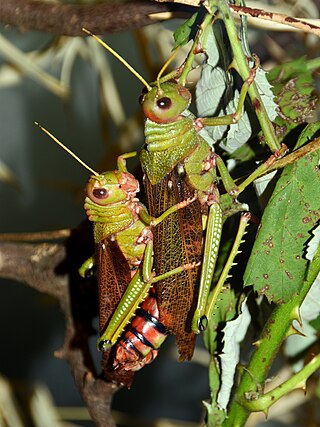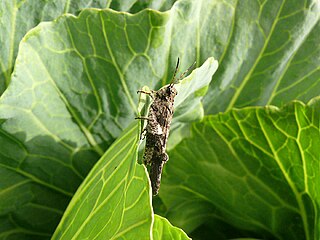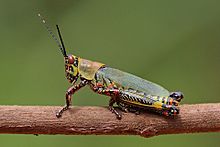
Petasida ephippigera, the Leichhardt's grasshopper, is a relatively large, brightly coloured pyrgomorph species of grasshopper in the monotypic genus Petasida, native to the Top End region of tropical northern Australia.

Phymateus is a genus of fairly large grasshoppers of the family Pyrgomorphidae, native to shrubland, semi-deserts, savanna, woodland, gardens and cultivated areas in Sub-Saharan Africa, with ten species in the African mainland and two species in Madagascar. Some species have bright aposematic colours and are highly toxic.

Tropidacris is a Neotropical genus of grasshopper in the family Romaleidae. They are among the largest grasshoppers in the world by length and wingspan, reaching up to 14.5 cm (5.7 in) and 24 cm (9.4 in) respectively. They are variably colored in green, brown, black, reddish or yellowish, and have wings that usually are conspicuously blue or red in flight. The gregarious and flightless nymphs have bright aposematic colors and are presumed to be toxic; a researcher who tasted one noted that it was very bitter, similar to a monarch butterfly.

Oedaleus is a genus of grasshoppers in the family Acrididae.

Dociostaurus is a genus of grasshoppers in the family Acrididae, subfamily Gomphocerinae and typical of the tribe Dociostaurini. Species are found in Africa, southern Europe and Asia, and includes the economically important Moroccan locust.

Diabolocatantops is a genus of grasshoppers in the subfamily Catantopinae and tribe Catantopini. Species can be found in Africa, India, China and Indo-China.

Poekilocerus is a genus of grasshoppers in the family Pyrgomorphidae and the monotypic tribe Poekilocerini. Species are found in the northern half of Africa, and in Southwest and South Asia, often in arid or semi-arid areas.
Tristria is a genus of grasshoppers in the subfamily Tropidopolinae with species found in Africa and tropical Asia.

Cyrtacanthacris is the type genus of grasshoppers in the subfamily Cyrtacanthacridinae. Species records are distributed in Africa through to Indo-China.

Stenocatantops is a genus of grasshoppers in the family Acrididae and subfamily Catantopinae. The recorded distribution of species includes: India, China, Indo-China and Malesia through to Australia.

Trilophidia is a genus of grasshoppers in the family Acrididae, subfamily Oedipodinae and the only member of the tribe Trilophidiini. The recorded distribution of species is from Africa and the middle-East through to Japan and Malesia.
Pternoscirta is a genus of grasshoppers in the family Acrididae, subfamily Oedipodinae and tribe Locustini. The recorded distribution of species includes: India, China, Indochina and Malesia.

Truxalis is a genus of grasshoppers in the family Acrididae, subfamily Acridinae and tribe Truxalini. Species can be found in: Africa, the Iberian peninsula, Asia minor through to Indo-China.

Tagasta is a genus of grasshoppers in the family Pyrgomorphidae, subfamily Pyrgomorphinae and tribe Tagastini. Species can be found around the Himalayan mountains, southern China, Indo-China and Malesia. It was described in 1905.

Callimenellus is an Asian genus of bush crickets in the subfamily Pseudophyllinae. It is the sole genus in the tribe Callimenellini.

Ducetia is the type genus of the Ducetiini: a tribe of bush crickets. The genus was erected by Carl Stål and species have a widespread distribution in Africa, Asia and Australia.

Tropidacris cristata, the giant red-winged grasshopper, is a widespread species of lubber grasshopper in the family Romaleidae from tropical South and Central America, and Mexico. It is among the largest grasshoppers in the world by length and wingspan, reaching up to 14.5 cm (5.7 in) and 24 cm (9.4 in) respectively. More typical adult lengths are 5.5–7 cm (2.2–2.8 in), average 6.5 cm (2.6 in), in males and 7–12 cm (2.8–4.7 in), average 11 cm (4.3 in), in females. As suggested by the common name, adult T. cristata have conspicuously red wings in flight, although the exact red hue varies. The flightless and gregarious nymphs have aposematic dark-and-yellow stripes and are presumed to be toxic.

Dictyophorus is the type genus of grasshoppers in the tribe Dictyophorini, of the family Pyrgomorphidae; it is native to sub-Saharan Africa. The genus was named by Carl Peter Thunberg in 1815. They are relatively large, typically about 4–7 cm (1.6–2.8 in) long, and often have bright colurs warning of their toxicity.

Zonocerus variegatus, the painted grasshopper or variegated grasshopper, is a species of insect belonging to the family Pyrgomorphidae. It is native to tropical Africa, and is considered a crop pest in much of Western and Central Africa.

Maura is a genus of grasshoppers in the tribe Dictyophorini and the family Pyrgomorphidae; it is native to sub-Saharan Africa.





















